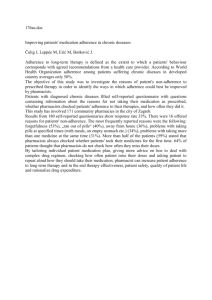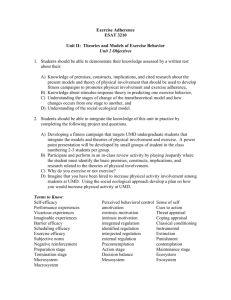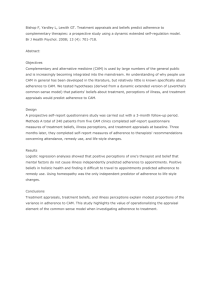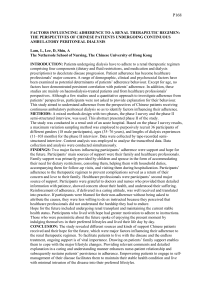Why this topic? Presentation Outline Why Study Exercise Behavior
advertisement
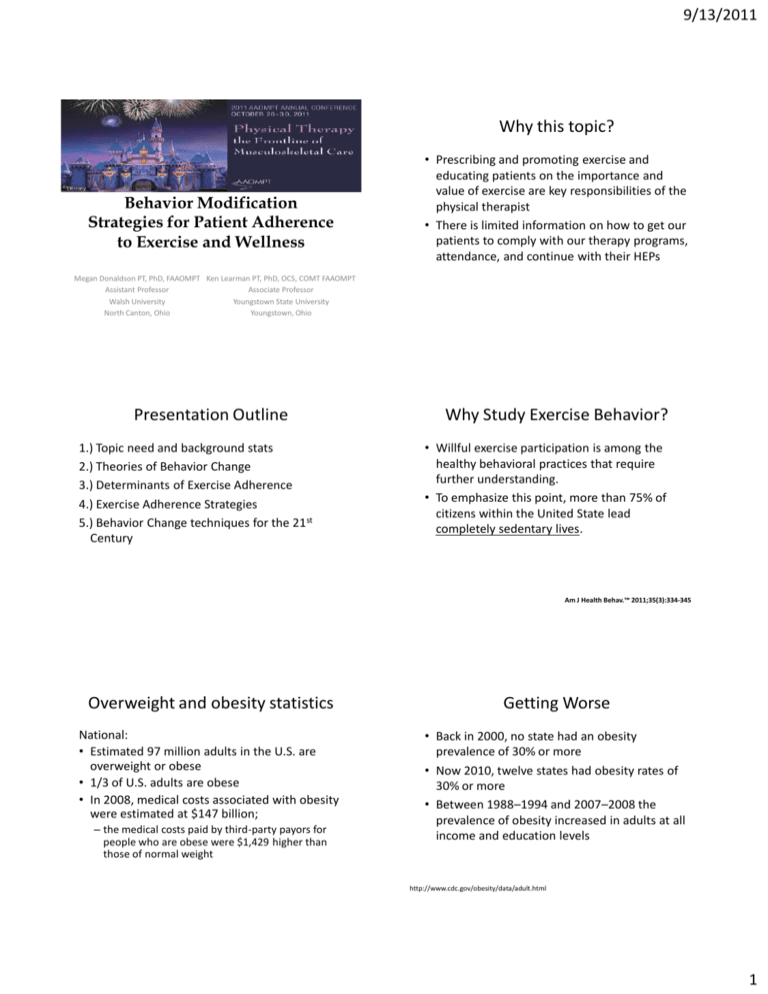
9/13/2011 Why this topic? Behavior Modification Strategies for Patient Adherence to Exercise and Wellness • Prescribing and promoting exercise and educating patients on the importance and value of exercise are key responsibilities of the physical therapist • There is limited information on how to get our patients to comply with our therapy programs, attendance, and continue with their HEPs Megan Donaldson PT, PhD, FAAOMPT Ken Learman PT, PhD, OCS, COMT FAAOMPT Assistant Professor Associate Professor Walsh University Youngstown State University North Canton, Ohio Youngstown, Ohio Presentation Outline 1.) Topic need and background stats 2.) Theories of Behavior Change 3.) Determinants of Exercise Adherence 4.) Exercise Adherence Strategies 5.) Behavior Change techniques for the 21st Century Why Study Exercise Behavior? • Willful exercise participation is among the healthy behavioral practices that require further understanding. • To emphasize this point, more than 75% of citizens within the United State lead completely sedentary lives. Am J Health Behav.™ 2011;35(3):334-345 Overweight and obesity statistics Getting Worse National: • Estimated 97 million adults in the U.S. are overweight or obese • 1/3 of U.S. adults are obese • In 2008, medical costs associated with obesity were estimated at $147 billion; • Back in 2000, no state had an obesity prevalence of 30% or more • Now 2010, twelve states had obesity rates of 30% or more • Between 1988–1994 and 2007–2008 the prevalence of obesity increased in adults at all income and education levels – the medical costs paid by third-party payors for people who are obese were $1,429 higher than those of normal weight http://www.cdc.gov/obesity/data/adult.html 1 9/13/2011 Impact of a “growing” problem • Childhood obesity can have a harmful effect on the body in a variety of ways. – High blood pressure and high cholesterol – Increased risk of impaired glucose tolerance, insulin resistance and type 2 diabetes – Breathing problems – Joint problems and musculoskeletal discomfort – Fatty liver disease, gallstones, and gastro-esophageal reflux (i.e., heartburn) – Social and psychological problems, such as discrimination and poor self-esteem EXERCISE STATISTICS • 50% of kids age 12 to 21, do not participate regularly in physical activity • 10-15% of adults exercise 3 times per week for at least 20 minutes • Physical activity declines steadily through adolescence from 70% at age 12 to 40% at age 21 • 10% of sedentary adults begin exercise programs each year • 50% of new exercisers will drop out within six months http://www.cdc.gov/obesity/childhood/basics.html, accessed 2011. Barlow SE and the Expert Committee. Expert committee recommendations regarding the prevention, assessment, and treatment of child and adolescent overweight and obesity: summary report. Pediatrics 2007;120 Supplement December 2007:S164—S192. Han JC, Lawlor DA, Kimm SY. Childhood obesity. Lancet. May 15 2010;375(9727):1737—1748. Sutherland ER. Obesity and asthma. Immunol Allergy Clin North Am. 2008;28(3):589—602, ix. Biro FM, Wien M. Childhood obesity and adult morbidities. Am J Clin Nutr. May 2010;91(5):1499S—1505S Exercise Adherence The Problem… • The ability to maintain an exercise program for an extended time period • One of the biggest health problems for American adults, children and adolescents • So you have the facts, now are you surprised that your patient doesn’t like to exercise? • How do you expect he/she to do her exercises at home or when you are not watching? – Possibly due in part to extensive reductions in required physical education classes Adherence • Poor adherence to exercise and treatment is a problem across a number of healthcare disciplines including physical therapy (Vasey, 1990; Friedrich et al., 1998; Campbell et al., 2001) • Studies that report non-adherence with treatment and exercise could be as high as 70% (Sluijs et al., 1993) • 14% of physical therapy patients did not return for follow up outpatient appointments (Vasey, 1990) Levels of Health Behavior • Primary prevention – Behaviors that a healthy person enacts in order to maximize well being and avoid particular diseases • Secondary prevention – Behaviors that an individual undertakes after a particular risk has been identified • Tertiary prevention – Behaviors are those that a persons undertakes in order to control the progression of a disease or cure it 2 9/13/2011 Perceived self efficacy THE THEORIES AND MODELS OF EXERCISE BEHAVIOR AND CHANGE Understanding Behavior Change • Some models have received more evaluation than others • Each are helpful in some contexts and may provide a useful structure to help us address the maintenance of health behavior change and adherence to treatment plans • Developments and research evidence frameworks explain the cognitive mechanisms of behavior change and adherence to treatment in the rehabilitation setting • Perceived self efficacy is concerned with people’s belief in their capabilities to produce given attainments (Bandura 1997). • There is no all purpose measure of perceived self efficacy as there is limited explanatory and predictive value because most of the items in all purpose test may have little or no relevance to the domain of functioning. (Martin 2010) • Self-efficacy is thought to be predictive of the amount of effort an individual will expend in initiating and maintaining a behavioral change, – it is an important element of many of the theories Belief and Attitude • Prominent in the theoretical models are constructs of “beliefs” and “attitudes” • Beliefs are the conclusions about the truth of something and are cognitive elements in the picture of how people evaluate and respond to ideas • Attitudes are the affective (emotional) elements based on the individuals personal feelings and emotions regarding a belief Schwarzer, R.; Lippke, S.; Luszczynska, A. “Mechanisms of health behavior change in persons with chronic illness or disability: The Health Action Process Approach (HAPA).” Rehabilitation Psychology, v. 56 issue 3, 2011, p. 161-70. EXERCISE BEHAVIOR THEORIES & MODELS 1.) Health Belief Model, 2.) Theory of Reasoned Action and Planned Behavior 3.) Self-Determination Theory 4.) Transtheoretical Model 5.) Social Cognitive Models 6.) Information-Motivation-Strategy Model Health Beliefs Model • The Health Belief Model focuses primarily on beliefs as the motivators of health behavior of the individual – 1.) Perceived susceptibility (an individual's assessment of their risk of getting the condition) – 2.) Perceived severity (assessment of the seriousness of the condition, and its potential consequences) – 3.) Perceived barriers (assessment of the influences that facilitate or discourage adoption of the promoted behavior) – 4.) Perceived benefits (assessment of the positive consequences of adopting the behavior) 3 9/13/2011 Health Beliefs Model Demographic Characteristics Perceived susceptibility to a disease Clues to Action Perceived severity or threat of a disease Perceived benefits Likelihood of engaging in preventive or treatment behavior Perceived barriers Self Efficacy http://en.wikipedia.org/wiki/File:Healthbeliefmodel.png#filelinks Created in OpenOffice.org Draw, based on Figure 7.2 page 137 of "Psychology in Practice; Health" Philip Banyard, published by Hodder & Stoughton 2002. Theory of Reasoned Action • Theorizes that people’s behaviors are primarily governed by their intentions, which are developed from their attitudes toward and social norms regarding those behaviors • According to the theory of reasoned action, if people evaluated the suggested behavior as positive (attitude), and if they think their significant others wanted them to perform the behavior (subjective norm), this results in a higher intention (motivation) and they are more likely to do so Sheppard, B.H.; Hartwick, J. & Warshaw, P.R. (1988). The theory of reasoned action: A meta-analysis of past research with recommendations for modifications and future research. Journal of Consumer Research, 15, 325–343. Transtheoretical Model of Change • Several processes of change were identified – 1. consciousness raising – 2. choosing among options – 3. contingency control (resources to help a person change their environment and associated system of rewards and punishments) Prochaska J. Systems of Psychotherapy: A transtheoretical anaylsis. Homewood, IL Dorsey Press; 1979. Prochaska JO, DiClemente CC. Stages and process of self-change of smoking: towad and integrative model of change. J Consult Clin Psychol 1983:51; 390-5. Health Beliefs Model • Self efficacy was added to the model and improved that ability of this model to predict behavior outcomes • Meta-analysis of this model identified that benefits and barriers were consistently the strongest predictors • Predictive of behavior, but only weakly so in comparison to social cognitive theory and especially as compared to the theory of reasoned action Carpenter, CJ. “A meta-analysis of the effectiveness of health belief model variables in predicting behavior.” Health Communication, v. 25 issue 8, 2010, p. 661-9. Theory of Planned Behavior • Expansion on TRA to target situation in which the individual does not have full control over the behavior in question • Behavior control is similar to self efficacy – Individual’s confidence that he/she can enact change – Improves predictive ability of the model Armitage CJ, Conner M. Efficacy of the Theory of Planned Behavior: a meta-analysis review. Br. J Soc Phychol. 2001 Madden TJ. Ellen PS. Ajzen I. A compariosn of the Theory of Planned Behavior and the Theory of Reasoned Action. Pers Soc Psychol Bull. 1992;18(1);3-9 TRANSTHEORETICAL MODEL Stage 1 = Pre-contemplation: Person isn’t performing self-change behavior and doesn’t intend to start. Initial notice of a problem Stage 2 = Contemplation: Person isn’t performing the self-change behavior but are thinking about starting. Action seriously considered Prochaska J. Systems of Psychotherapy: A transtheoretical anaylsis. Homewood, IL Dorsey Press; 1979 4 9/13/2011 TRANSTHEORETICAL MODEL Stage 3 = Preparation: Person recently started preparing to initiate self-change behavior such as buying clothing and shoes, purchasing a fitness membership or lining up an exercise partner Stage 4 = Action: Person has initiated the selfchange behavior consistently for a short period of time. Trying to become more systematic Prochaska J. Systems of Psychotherapy: A transtheoretical anaylsis. Homewood, IL Dorsey Press; 1979 The Evidence of the Transtheoretical Model • A meta-analysis revealed that the distinction in the various processes of change were less clear in studies of exercise than psychotherapy and addictive behavior • The model breaks down further when timeframes are included in staging TRANSTHEORETICAL MODEL Stage 5 = Maintenance: Person has maintained the self-change behavior consistently for 6 months or more and plans to continue doing so. Reached habitual stage Stage 6 = Relapse Prevention: Person encounters serious lifestyle change after reaching maintenance stage and has to adjust self change program to prevent relapse. Making needed adjustments to maintain lifestyle change Prochaska J. Systems of Psychotherapy: A transtheoretical anaylsis. Homewood, IL Dorsey Press; 1979 Some thoughts based on the models • The Transtheoretical model highlights two important concepts about behavior change: – Verbal communication and cognitive processing in the early stages of change are important – If the clinician’s focus and direction are too different from the patient or if they are working at different levels of change process, patient’s may become resistant to change and quit PT or drop out – Effective communication is key for early stage change and identifying the appropriate level of the patient to target interventions Marshall SJ. Biddle SJ. The Transtheortical Model of behavior change: a meta-analysis of applications to phsyical activity and exercise. Ann Behav Med. 2001: 23:229-46. Social Cognitive Theory • There are some similarities of this model and the Health Belief Model • Critically this model includes cognitive elements of self-efficacy as part of the personal factors and expectancies Social learning/social cognitive theory • Behavioral change is determined by – Environmental – Personal – Behavioral elements 5 9/13/2011 Information Motivation Strategy Model Information- Motivation Strategy Model • Conceptual approach to guiding adherence and health behavior change • Simplifies and consolidates many components of the previous models and including a boarder range of health-related behaviors • Basic principles underlying this model and before someone can achieve health behavior change a patient must undergo Information Motivation – Knowledge that the change is necessary (information) – Have the desire to change (motivation) – Necessary tools to achieve and then maintain the change (strategy) • Significant amount of evidence links each of these components to positive patient outcomes including behavior change and adherence Health Behavior Change and/or Adherence Strategy REASONS ADULTS EXERCISE DETERMINANTS OF EXERCISE ADHERENCE • Weight control for appearance and health • Health benefits--particularly for cardiovascular problems (i.e., hypertension) • Stress and depression management • Enjoyment • Building self-esteem • Social and affiliation benefits EXERCISE BARRIERS • • • • • • • • Lack of time Lack of energy Lack of motivation Social support barriers Health and fitness barriers Other commitments Resource barriers Programming barriers personal factors environmental factors EXERCISE ADHERENCE STRATEGIES 6 9/13/2011 BEST EXERCISE ADHERENCE STRATEGIES Make exercise fun and enjoyable Tailor exercise frequency, duration and intensity to the exerciser Promote group exercise Keep daily exercise logs Reinforce success Find a convenient place to exercise BEHAVIOR MODIFICATION APPROACHES • • • • • • • • • • Behavior modification approaches Reinforcement approaches Cognitive-behavioral approaches Decision Making approaches Social support approaches Intrinsic approaches REINFORCEMENT APPROACHES • Charting attendance and participation • Rewarding attendance and participation • Feedback and testing Prompts and Charts Behavior contracts Perceived choice Stimulus control COGNITIVE-BEHAVIORAL APPROACHES • • • • • EXERCISE ADHERENCE STRATEGIES DECISION MAKING APPROACHES • Pros and Cons list Goals Self talk Thought focus strategies Association Dissociation – Personal barriers http://www.womenwritingnow.com/writing-therapy-tips-for-building-selfesteem.html 7 9/13/2011 SOCIAL SUPPORT APPROACHES INTRINSIC APPROACHES • Social support from partner, group or class • Know where to go for what you need • Must trust and respect person to go to them for support • Focus on the experience • Focus on the process • Engage in meaningful physical activity Adherence Strategies Evidence • Research suggests behavior modification has a greater impact on increasing physical activity than other approaches such as cognitivebehavioral modification • Lack of research regarding the best behavioral modification strategies and techniques to motivate adults to exercise • Two techniques in behavior modification that have brought about the most success in adherence have been – 1.) behavior contracting – 2.) stimulus control Behavior Contract • A behavior contract is an appropriate technique to motivate adults to exercise because it creates intrinsic motivation, is an individualized technique that increases: – Locus of control (Homme, & Hazler, 1999; Homme, Csanyi, Gonzales, & Rechs, 1970; Kelley & Stokes, 1982; Langstaff & Volkmor, 1975), – Creates consistency of goals (Gambrill, 1987; Tharp & Wetzel, 1969), – Encourages active participation and selfdetermination (White-Blackburn, Semb, & Semb, 1977), – Teaches independence and self-control (Homme, Csanyi, Gonzales, & Rechs, 1970; Kabler, 1976). Dishman & Buckworth, 1997 Owen & Sallis, 1999 Sample of a Behavior Contract Who needs a contract • Ask yourself 3 questions: – Is the behavior changeable? – Is the behavior measureable? – Is the behavior persistent? 8 9/13/2011 Writing Behavior Contract Tips Stimulus Control • Make the contract specific and individualized • Write the goal stated as the desired behavior, NOT as the behavior to be stopped • Make the contract measurable and observable • Some patients may require appropriate consequences (talk with your referring docs about this) and rewards • Include the patient in this contract and goal writing • Stimulus control is a behavioral technique in which prompts are supplementary stimuli used to increase the likelihood that an individual will produce a specific response such as exercise in the presence of the stimuli that will eventually control behavior (Billingsley & Stimulus Control Stimulus Control Examples • Step 1) First step is for the client to self-monitor his or her exercise behavior • Step 2) Work with patient to developing an environment conducive to promoting exercise (Dishman, 1988) – The time, place, and individuals that compose the environment for exercise will then represent the cues for those who adhere to the exercise program • Step 3) Decrease of cues for competing behaviors Romer, 1983; Snell, 1983). • Stimulus control involves providing stimuli that will increase the chances of engaging in the desired behavior. • Examples: place exercise shoes, water bottle in sight, picture of HEP on mirror in bathroom, copy of exercise log by the TV remote, exercise photos on the refrigerator door as a constant reminder (Martin & Dubbert, 1987) Stimulus Control Ideas • The clinician can promote this process by helping the client identify specific times and locations that promote adherence, so that there are no competing cues, and the individual can successfully adhere to his or her exercise program • “Meet group at 6am on the running trail” http://www.mooreonrunning.com/2010/12/motivation-to-run.html 9 9/13/2011 Compliance Charts • Modifying behavior comes with being consistent • Using a system of rewards and consequences may help facilitate good compliances. – Attendance of all visits without no shows and rescheduling of all visits results in a 1 month fitness pass at then end of physical therapy. – For diet, one “binge” day per week Improving Exercise and HEP Adherence Group Exercise • Group training builds in accountability • The group is let down when you don’t attend • Socialization is lost if patient does not attend • Vicarious experiences are helpful for motivation • Another factor to take into consideration is that research has indicated that exercising alone will result in a greater dropout rate than exercising as a group Exercise Adherence and Behavior Change • Behavioral techniques are important contributors to a successful exercise program – Contracting and stimulus control are thought to be the promoters of exercise adherence behavior • Goal setting and self-monitoring help maintain exercise adherence behavior Exercise Adherence and Behavior Change • Follow up with your patient • Ask to see their log • Ask to see them perform a few of their HEP to ensure good form • Ask them which exercises they are doing • “Which ones do you like” Schwarzer, R.; Lippke, S.; Luszczynska, A. “Mechanisms of health behavior change in persons with chronic illness or disability: The Health Action Process Approach (HAPA).” Rehabilitation Psychology, v. 56 issue 3, 2011, p. 161-70. Pearson, ES. “Goal setting as a health behavior change strategy in overweight and obese adults: A systematic literature review examining intervention components.” Patient Education and Counseling, 2011. 10 9/13/2011 Behavior Change • Both behavior modification and cognitive behavioral methods have demonstrated success in reducing the dropout rate of exercisers • Utilizing reinforcement for healthy behaviors, contracting, self-monitoring, instruction, goal setting, increasing self-efficacy, and assisting in relapse prevention improves adherence to physical activity programs by roughly 15% to 20% (Dishman & Buckworth, 1997) Goals • Goals should be flexible • Goals need to be individually tailored and OWNED by the patient • Goals should also be realistic with respect to the time necessary to achieve the goal and the client's expectations. – more effective to set smaller, more achievable goals so the client can experience success (Annesi, 1996) – Baby steps….. • Check goal setting and achievement progress regularly for motivation and feedback (Annesi, 1996) Goal Contracting • Write goals with your patient and give them a copy in their own words – Use these in a modified version for your documentation • Make it a contract with the patient with regular checking up Goals and Contracting • Contracting is a technique used in conjunction with goal setting • Develop a contract that clearly describes the exercise program, the clients' goals, the benefits of doing the activity/exercise, and what is expected from the client • Be aware, before developing the contract, of the client's readiness level (Transtheoretical Model) • Once the client signs the contract he or she is assuming responsibility for the exercise program and the goals become intrinsically embedded (Prochaska et al., 1991) Goal Framing • Framing goals may influence whether or not a person stays actively engaged in pursuit of their goal • Research shows that people who think about their goals as steps towards increasing their skills (instead of performance indicators) remain engaged in trying to achieve those goals even following failure Goal and Behavior Change Contracting • Contracts have been found to be effective across a variety of domains • Applies subtle social pressure by reminding people that they have promised to follow up on the things that they made a commitment • Currently, limited evidence that contracts can potentially contribute to improving adherence – but there is insufficient evidence from large, good quality studies to routinely recommend contracts for improving adherence to treatment or preventive health regimens Bosch-Capblanch, X.; Abba, K.; Prictor, M.; Garner, P. “Contracts between patients and healthcare practitioners for improving patients' adherence to treatment, prevention and health promotion activities.” Cochrane Database Syst Rev, issue 2, 2009, Elliott ES, Dweck CS. Goals: An approach to motivation and achievement. J pers Soc Psychol. 1988; 54(1):5-12 Gerber, JB.; Bloom, PA.; Ross, JS. “The physical activity contract--tailored to promote physical activity in a geriatric outpatient setting: a pilot study.” Journal of the American Geriatrics Society, v. 58 issue 3, 2010, p. 604-6. Liberman, A.; Rotarius, T. “Behavioral contract management: a prescription for employee and patient compliance.” The Health Care Manager, v. 18 issue 2, 1999, p. 1-10. 11 9/13/2011 Intrinsic Motivation Intrinsic Motivators • Caution when implementing behavior modification techniques with external rewards sometimes diminish the intrinsic motivation • Some patient’s develop by the body changes that can be produced through exercise such as weight loss or increase of muscle tone and definition • By maintaining a level of enjoyment, the individual will feel motivated to continue with the exercise program • Frequently, asking the client his or her level of enjoyment will increase maintenance • In addition, those clients who believe in the value of exercise for their specific benefit have a greater possibility of incorporating and maintaining exercise as part of their lifestyle (Dishman, Sallis, & Orenstein, 1985) Deci, EL.; Koestner, R.; Ryan, RM. “A meta-analytic review of experiments examining the effects of extrinsic rewards on intrinsic motivation.” Psychological Bulletin, v. 125 issue 6, 1999, p. 627-68; discussion 692-700. Motivational Interviewing • Behavioral modification strategy developed to assist in substance abuse care but found to have wider spread implications • 4 steps Listening to the Client • Time must be allotted to allow the client to work through what changes should occur in their lives • Empathy is important – Listening to the client – Help client to identify reasons for change – Let Internal resistance to exist – Provide the client assurance Identify Importance of Change Work Through Resistance • Client driven and HCP supported identification of importance of change • Client needs to internalize the stated arguments and will likely develop resistance to change • HCP must respect this resistance as part of the process • Allow the internal resistance to exist • Work through the internal resistance with the client 12 9/13/2011 Client Assurance • Time must be taken to assure the client that they are capable of making the desirable behavioral change • Self-belief encourages success in modification Evidence • MI resulted in greater weight loss and BMI reduction • ES of 0.51 in one Meta-analysis and 0.56 in another • Individual studies Rollnick S et al. Motivational Interviewing in Healthcare: Helping patients change behavior. New York. Guilford Press; 2008. Armstrong MJ et al. Motivational interviewing to improve weight loss in overweight and/or obese patients: a systematic review and meta-analysis of randomized controlled trials. Obes Rev. 2011;12(9):709-23 Reality…. “At Risk Group” • Outreach groups – Need a safe place to do exercises • Patients/clients may receive emotional support from other individuals that exercise with them (Martin & Dubbert, 1987) • It is expected that if clients are not motivated to exercise, the possibilities of dropout from the exercise program are high Identify Safe places to reduce barriers Schwarzer, R.; Lippke, S.; Luszczynska, A. “Mechanisms of health behavior change in persons with chronic illness or disability: The Health Action Process Approach (HAPA).” Rehabilitation Psychology, v. 56 issue 3, 2011, p. 161-70. Facilitating Behavior Change Facilitating Behavior Change • Facilitating treatment adherence and relapse prevention, the patient/client must internalize the concept that he or she can succeed in this doing the task or activity (Sonstroem, 1997) • Exercise programs must be composed of one small goal that can be reached in a short period of time and a long-term goal (Dishman & Buckworth, 1997) • The purpose of the PATIENT DRIVEN short-term goal is to ensure a feeling of self-efficacy as he or she achieves this goal • Tailoring of the exercise program is one of the fundamental keys in exercise adherence and maintenance • Research has shown that clients who believed that their program is specifically designed for them continue longer than those who don't have that same impression (Ganley & Sherman, 2000) 13 9/13/2011 Facilitating Behavior Change • Creating an internal locus of control • Research shows that individuals who believe that they are able to produce change have the highest performance rate (Carter, Lee, & Greenockle, 1987) • These changes may include self-efficacy regarding aerobic exercise and greater internal locus of control of health benefits (Labbe & Welsh, Strategies for Increasing Self-Efficacy • People acquire their self-efficacy beliefs from the following four sources: – past performance – vicarious experiences (observing others perform) – verbal persuasion – physiological cues 1993) Martin LR, Haskard-Zolnierek KB, DiMatteo MR. Health Behavior Change and Treatment Adherence. 2010 Oxford University Press. Strategies for Increasing Self-Efficacy • Enactive Attainments – personal experiences of success – Set small steps toward behavior change so that success can be experienced early – Discuss with patients their past successes so that these are prominent Martin LR, Haskard-Zolnierek KB, DiMatteo MR. Health Behavior Change and Treatment Adherence. 2010 Oxford University Press. Strategies for Increasing Self-Efficacy • Vicarious Experiences- Seeing the successes of similar others – Share the success stories of others (no names HIPAA) – Engage patients in groups where they can view successful change – Participation in groups also means that dropping out affects others Martin LR, Haskard-Zolnierek KB, DiMatteo MR. Health Behavior Change and Treatment Adherence. 2010 Oxford University Press. Strategies for Increasing Self-Efficacy • Verbal Persuasion- being told that one is capable – Assure the patient of their ability – Provide rationale for your belief about the patient’s capability to be successful • Physiological arousal – Help patients channel their feelings into their workout or activity and use that “nervous” “anxious” or “frustration” energy BEHAVIOR CHANGE TECHNIQUES FOR THE 21ST CENTURY Martin LR, Haskard-Zolnierek KB, DiMatteo MR. Health Behavior Change and Treatment Adherence. 2010 Oxford University Press. 14 9/13/2011 Technology in Behavior Change • When new behaviors are considered fun, adherence may be enhanced • Technology has been used to make physical activity fun (Bailey,2011) • Nintendo Wii, Dance Dance Revolution, Microsoft Kinect all are interactive games that increase activity Am J Prev Med 2002;22(4S):73–107) Gaming & Physical Activity • Interactive gaming can be used to increase fitness and improve balance – Wii tennis and boxing created moderate activity levels for pts with chronic stroke (Hurkmans,2001) – Wii increased balance in healthy women aged 3060 (Nitz,2010) • Games are intergenerational and some report that participating brings families together and is considered “quality time” http://www.gamertell.com/technologytell/article/84-year-woman-crowned-community-wiibowling-champion/ Music/TV • iPods or their equivalent are used to make the exercise environment more fun • Audio or visual stimulation may make time pass faster while exercising • Subjects report that a gaming exercise cycle makes it more enjoyable than riding a standard stationary bike increasing adherence (Rhodes,2009) Monitors of Physiologic Effort • HR monitors, power meters, real-time GPS all give routine feedback which can help motivate exercisers to attain higher level goals • Feedback can prevent subjects from exercising too hard which can discourage participation Internet Feedback • Online exercise logs to record details of workouts • Social networking for group support of exercise or behavioral modification efforts (Vincz,2010) Hand Held Devices • Customized smartphones can be used to track dietary intake and physical activity giving color coded feedback real-time • The effects of this technology are currently under investigation (Coons,2011) • Systematic review suggests that self-monitoring these variables works. (Burke,2011) • A PDA has been shown to be effective for self-monitoring of diet and exercise (Burke,2011) 15 9/13/2011 Summary • Best predictor of future behavior is previous behavior • Change readiness may be identified by using models and should take strategies early to modify behavior • Behavior change methods may change depending on stage, but self-efficacy is a strong predictor of success • Technologies can be used to tap into the generation gap, but listen to your patient and make it individualized for them 16
